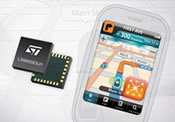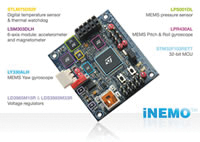Multisensor Devices Speed Up Design, Simplify Supply Chain, Cut Costs
Contributed By Electronic Products
2010-07-08
There is no doubt that designers of next-generation smartphones will add gyroscopes to their bills of material for enhanced gaming functionality and indoor location-based services.
Some suppliers, such as STMicroelectronics, are making it easier for designers by incorporating analog-to-digital converter channels in their accelerometers for easier integration with gyroscopes and other companion chips.
But, most likely, going forward, we will start to see, in addition to multi-axis gyroscopes, more multisensor packages that combine accelerometers and a gyroscope.
Driving the demand for these multisensor devices, particularly for mobile phones and gaming platforms, will be the need to ease design and simplify the supply chain. While many digital compasses already incorporate accelerometers for GPS phones, gyroscopes (aka regular-rate or yaw sensors) and accelerometers are just now starting to be integrated in the same module.
Like any other integrated device, an important step in their widespread adoption will be competitive pricing compared to discrete solutions.
While the key motivations for high integration are saving space and simplifying the design work for signal processing, integration also has to be cheaper than discrete solutions, said Jérémie Bouchaud, director and principal analyst MEMS, iSuppli Corporation.
According to Bouchaud, multisensor packages cost about 10 to 15 percent less than the costs of individual sensors.
The compass for a GPS phone always needs an accelerometer for calibration, which is why it makes sense to integrate it in the same package, said Bouchaud. The same thing will happen with gyroscopes, particularly for cell phone and gaming applications, he said.
“There are already examples for STMicroelectronics that incorporate a 2-axis gyroscope with a 3-axis accelerometer, and I expect a 6-axis sensor that combines a 3-axis gyro and a 3-axis accelerometer will be available later this year,” Bouchaud said.
“It’s not easy to integrate these two different technologies. Until now, it was more expensive to buy an integrated package than to buy the compass and accelerometer as two separate devices. But ST, together with Honeywell, for example, has developed a 6-axis compass – combining a 3-axis accelerometer and a 3-axis gyro, which is very competitive with discrete solutions,” said Bouchaud.
Industry analyst iSuppli forecasts that 30 percent of motion sensors will ship as part of multisensor MEMS packages by 2014, up from one percent in 2009. The market researcher expects the six-degrees-of-freedom (DoF) compass, which combines a 3-axis compass and 3-axis accelerometer, to be the primary solution, followed by 6-axis inertial measurement units (IMUs) that combine a gyroscope and an accelerometer.
The following are several offerings from a few leading suppliers:
In January, STMicroelectronics integrated a 3-axis digital accelerometer with a 3-axis digital magnetic sensor in a single module. The benefits include high accuracy, small form factor, and low power consumption for advanced navigation and emerging smart location-based services.
ST’s LSM303DLH digital compass module fits in a 5 x 5 x 5-mm package and is software- and register-compatible with the company’s 3-axis digital accelerometer family (LIS331DLH/M/F). The digital compass integrates a magnetic sensing element, based on Honeywell’s anisotropic magneto-resistive (AMR) technology, with a ST MEMS-based 3-axis digital accelerometer, featuring six DoF.

Honeywell’s AMR technology provides the same sensitivity on the z axis as it does on the x and y axes, eliminating the need for flux concentrators used in Hall-effect type sensors that can shift the sensor offset after it has been magnetized, said ST. In addition, this 3-axis sensing approach reduces measurement errors in ultra-low magnetic field strength environments, such as metal buildings, vehicles, or in higher latitudes such as Canada or Northern Europe.
Another integrated product from ST is the LSM320HAY30 inertial module, which integrates a 3-axis digital accelerometer with a 2-axis analog gyroscope in a single package. The device features a user-selectable, full-scale acceleration range of ±2g/±4g/±8g and angular rate detection from 30 to 6,000 dps along the pitch and yaw axes.
The LSM320HAY30 can measure five DoF for advanced applications such as high-precision gesture and motion recognition in mobile phones, remote controllers, and personal navigation systems.
STMicroelectronics also introduced the first parts in its iNEMO family of multisensor inertial measurement unit (IMU) devices this year. The introduction also marks ST’s first IMU with 10 DoF. These devices integrate a variety of motion, magnetic, pressure, and temperature sensors with a 32-bit processing unit and dedicated software in one package, aimed at improving functionality in a number of applications ranging from gaming to patient monitoring.

ST’s first iNEMO module – the STEVAL-MKI06V1 – integrates six different sensors and a 32-bit microcontroller and is available as a 4.5 x 5-cm evaluation board with a firmware library, a PC graphical user interface, and a set of software solutions for different applications.
Industrial applications are also calling for higher integration. Case in point: VTI’s gyro-accelerometer combo sensor.
The VTI device combines a 3-axis accelerometer with a near tactical grade 1-axis gyro in the same package, aimed at applications such as IMUs, platform control and stabilization, motion analysis and control, as well as guidance and navigation systems.
All angular-rate sensors are said to feature outstanding insensitivity to shock and vibration. The sensors are temperature compensated over the operating temperature range of -40 to 125°C. The combo versions feature two separate digital SPI-interfaces (one for the gyro and one for the accelerometer).
The lead-frame-based package measures 18.65 x 8.5 x 4.53-mm (length x width x height). Volume production began in the first half of 2010.
Disclaimer: The opinions, beliefs, and viewpoints expressed by the various authors and/or forum participants on this website do not necessarily reflect the opinions, beliefs, and viewpoints of DigiKey or official policies of DigiKey.






